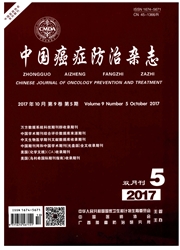

 中文摘要:
中文摘要:
目的探讨miR-144在肝癌组织中的表达水平及其对肝癌细胞生物学功能的影响,并分析其临床意义。方法通过qRT-PCR法检测肝癌及其癌旁组织中miR-144的表达,以瞬时转染建立人肝癌细胞过表达miR-144模型,采用CCK-8和细胞克隆形成实验检测转染后肝癌细胞的增殖和细胞克隆形成能力,采用流式细胞术、Transwell法检测肝癌细胞的细胞周期和迁移能力,分析miR-144的表达水平对肝癌细胞生物学功能的影响及其与临床病理特征的关系。结果 miR-144在肝癌组织中的表达明显低于癌旁组织(P〈0.05);与未处理及阴性对照的肝癌细胞相比,过表达的miR-144均能有效抑制肝癌细胞的增殖、细胞克隆形成及迁移能力(P均〈0.05),并诱导细胞周期阻滞在S期(P〈0.05);miR-144高表达组的肝癌患者术后生存时间长于低表达组(P〈0.05),miR-144的表达与患者性别、年龄、乙肝病毒感染、肿瘤大小、肿瘤个数、AFP、临床分期等临床病理特征无明显相关(P均〉0.05)。结论 miR-144在肝癌组织中低表达且与预后相关,过表达的miR-144能够抑制肝癌细胞的增殖和迁移。
 英文摘要:
英文摘要:
Objective To investigate the expression of miR-144 in hepatocellular carcinoma (HCC) tissue and its relationship with clinicopathological factors, as well as its function in cells. Methods Expression of miR-144 in HCC and adjacent noncancerous tissue from patients was quantitated using qRT-PCR, and levels were compared with clinicopathological factors to identify possible correlations. Mimics of miR-144 and a negative control (NC) sequence were transfected into human HCC cell lines,which were analyzed in terms of proliferation (CCK-8 assay),colony formation and migration (transwell assay) as well as cell cycle(flow cytometry). Results Expression of miR-144 was significantly lower in HCC samples than in matched controls (P〈0.05). Overexpression of miR-144 in HCC cell lines, but not the non-treated or the NC sequence, significantly reduced proliferation, colony formation and migration (P〈0.05), as well as arrested the cell cycle in S phase. Postoperative survival was longer in HCC patients showing high miR-144 expression than in those showing low expression(P〈0.05). Other clinicopathological factors, however, did not correlate with miR-144 expression, including tumor size or number,AFP (P〉0.05). Conclusion Frequently downregulated in HCC tissues,miR-144 acts as a tumor suppressor and may serve as a prognostic factor.
 同期刊论文项目
同期刊论文项目
 同项目期刊论文
同项目期刊论文
 期刊信息
期刊信息
